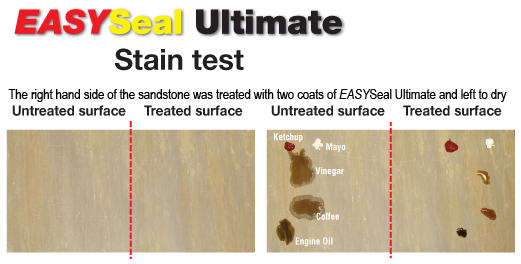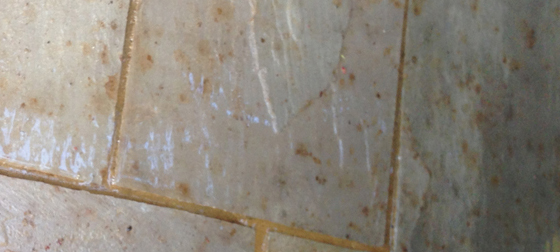At Azpects you will often hear us talking about sensitive paving materials but what actually are they and what do you need to know?
Sensitive paving materials are commonly used across the hard landscaping industry for patios, paths and drives, they are often beautiful and hard wearing but can be highly absorbent to all manner of substances man-made and organic which they simply wouldn’t be exposed to deep underground from where they originate.
Sensitive paving materials can be particularly susceptible to soaking up all manner of contaminants whether that it is water, oil and even minerals from the bedding mix below the slabs themselves. Items which are soluble in water such as salt can absorb into the slabs and leach through to the surface causing efflorescence.
Which Stone types are sensitive?
Firstly, natural stone by it’s very nature varies even between the same stone types.
Sandstone - Some Indian Sandstone such as Mint Fossil is classed as soft, whilst others such as Raj, Modak or Buff Brown can be classified as a hard stone. This means that the softer stone types are more prone to dirt ingress and will require more looking after than a harder, more dense stone. You have to remember you could have two types of the same natural stone from different sides of the world forged in different conditions and environments. However, as a general rule of thumb, these stone types in our experience are the ones you need to take particular care with if don’t want reoccurring issues at a later date.
Slate - You would think a dense stone like slate which is used in roofing would be totally impermeable.
If you were to look at the permeability of slate you will find it is very slightly permeable. Welsh Slate is less permeable than Chinese Slate. That’s not to say that Chinese, Indian or Brazilian Slate is inferior, it’s just not as dense but makes good roofing and patio tiles.
Granite - This is the number one cause of paving problems we encounter; it’s incredibly porous and has even been known to suck bedding materials to the surface of the slabs, leaving horrible stains which are intrusive and difficult to remove. If you are using Granite for a landscaping job we recommend sealing all six sides of the slabs before installation. If you are an unfortunate victim of a stained granite patio consult expert advice from cleaning professionals. We hear horror stories from people who have applied chemicals such as brick acid on their granite patios only to make their problem ten times worse.
Black Limestone - It looks great in the shop with a striking jet black finish but in many cases, it begins to fade to a dull grey colour, something you don’t want to see if you’ve just forked out thousands of pounds on a new patio. It’s such a common issue we’ve actually designed a product to rectify the issue (EASYSeal Back to Black Limestone).
Polished Sandstone and Darker Stones – Sandstone varies massively but Polished Sandstone, in particular, is more susceptible to marking than other forms. Darker Stones are not always more at risk than lighter stones but if they do get marked, the stains are more visible because of colour contrasts and the way light reflects off the stone. Any machining to a stone's surface will reduce its permeability which can make sealing and cleaning much harder. The smoother the surface, the less permeable it can be.
What can I do to minimise the risk? Seal your paving, it is not a total defence of your paving, paving will still be exposed to dirt and will need cleaning occasionally, we recommend pressure washing a patio once or twice a year. but sealers will give you a bit more time to get to the area and clean it off, think of them as a safety barrier between the outdoor environment and your stone. They are excellent at resisting staining from items such as tea, coffee, ketchup, fat, oil etc, giving you time to get to them and clean them off.

An example of what stone would look like with various substances spilt onto them, protected and unprotected as seen above
Acids from berries, leaves and bird poo are one of the most challenging issues in the construction industry. Acids will eat through even the most resilient sealers so we'd always suggest you remove these items from your patio as soon as possible.
 Rust stains can be caused by the acid from berries eating into the stone, freeing up iron deposits to oxidise on the surface.
Rust stains can be caused by the acid from berries eating into the stone, freeing up iron deposits to oxidise on the surface.
What about Efflorescence?
Stone suppliers will often recommend leaving natural stone a few months before sealing it, this is because some sealers create a 'skin' and are not classed as breathable. Skin based sealers can trap contaminants such as salt under this skin layer causing blooming. Most of Azpects products from the EASYSeal range are breathable to negate this problem (refer to the product web pages or bottle labels for more information).
In conclusion - be cautious, we are not saying you shouldn’t use these stone types but do your homework and make sure you know the risks. If several thousand pounds have been spent on a patio, an extra hundred pounds or so on a good sealer is well worth the investment. Sealers won't keep your patio clean but it make it easier to maintain. We recommend general maintenance and care to keep your patio looking it's best.
Leave us a comment below!
For information on our full list of products visit: http://www.azpects.co.uk/products.aspx
Azpects on Facebook: https://www.facebook.com/AzpectsLtd/
Azpects on Twitter: https://twitter.com/AzpectsLtd